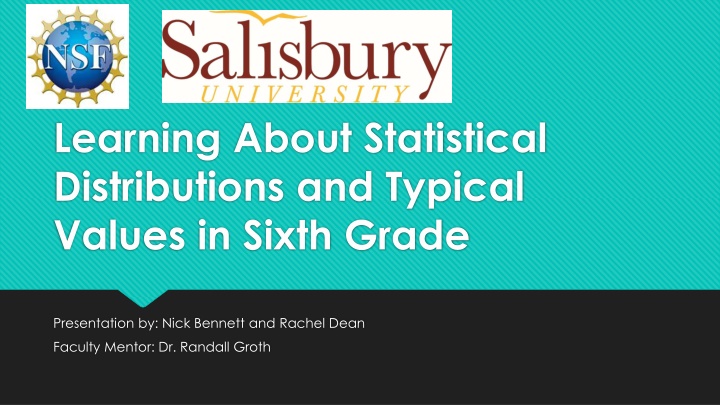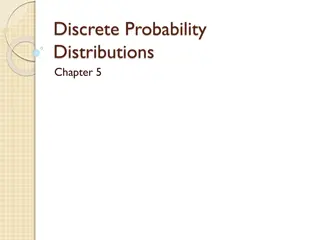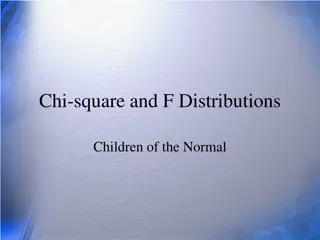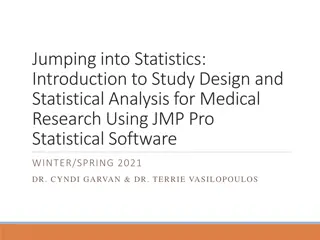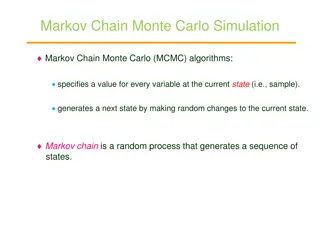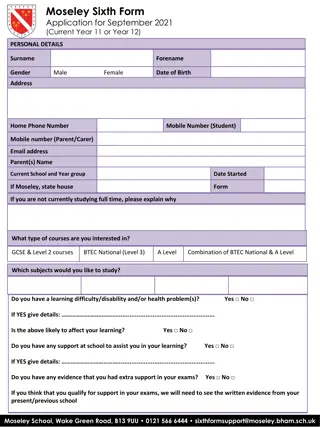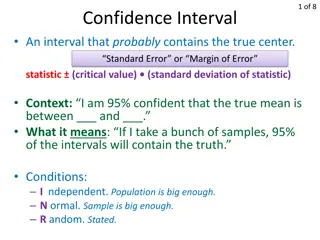Statistical Distributions in Sixth Grade Study
The study examines how sixth-grade students perceive data aggregates and typical values, exploring their understanding before, during, and after instruction through a design-based research cycle. Utilizing a problem-based approach aligned with Common Core State Standards, the research aims to enhance students' grasp of statistical concepts.
Download Presentation

Please find below an Image/Link to download the presentation.
The content on the website is provided AS IS for your information and personal use only. It may not be sold, licensed, or shared on other websites without obtaining consent from the author.If you encounter any issues during the download, it is possible that the publisher has removed the file from their server.
You are allowed to download the files provided on this website for personal or commercial use, subject to the condition that they are used lawfully. All files are the property of their respective owners.
The content on the website is provided AS IS for your information and personal use only. It may not be sold, licensed, or shared on other websites without obtaining consent from the author.
E N D
Presentation Transcript
Learning About Statistical Distributions and Typical Values in Sixth Grade Presentation by: Nick Bennett and Rachel Dean Faculty Mentor: Dr. Randall Groth
Introduction Students must develop graph sense (Friel, Curico, & Bright, 2001), view data represented in a graph as an aggregate (Bakker & Gravemeijer, 2004), and avoid strictly procedural conceptions of measures of center (Mokros & Russell, 1995) in order to discern typical values in distributions. The main question guiding our study was How does a group of children entering sixth grade organize data, perceive aggregates, and determine typical values before, during, and after instruction?
Literature Review In order to increase understanding and ability to solve unfamiliar and complex problems, students should be given problem-based tasks (Boaler, 1998, Boaler & Humphreys, 2005). As students begin studying statistics, appropriate tasks to pose include those that involve organizing data (Curcio, 2010), describing aggregate features of distributions (Konold et al., 2014), comparing groups (Noll & Kirin, 2017), and making predictions from data (English, 2012).
Common Core Learning Progression 6.SP.1 Recognize statistical questions as associated with variability in the data. 6.SP.5.a Report the number of observations. 6.SP.2 - Understand distributions of data as described by center, spread, and overall shape. 6.SP.5.b Describe attribute, how it s measured, and units of measurement. 6.SP.5.c Describe measures of center (median, mean) and variability (interquartile range, mean absolute deviation) in relation to context. 6. SP.3 Recognize measures of center and measures of variation as single values representing data sets. 6.SP.4 Display numerical data in plots on a number line (dot plots, histograms, and box plots). 6.SP.5.d Relate choice of measures of center and variability to shape of the data distribution.
Methodology Four students, two male and two female, who completed fifth grade and were advancing into sixth grade participated in the study. Three of the students attended all sessions and one of the students missed two lessons. Pseudonyms assigned to the students are: Allison, Andrew, Brian, and Claire. To design the lessons for each week, we utilized a design-based research cycle to analyze the students reasoning.
Methodology To get a baseline of the students knowledge prior to the program, we gave a pre-assessment of key items that had topics related to our research. The questions follow the sixth grade learning progression, and are aligned to the Common Core State Standards for Mathematics.
Key Item 1 Below are the 25 birth weights, in ounces, of all the Labrador Retriever puppies born at Kingston Kennels in the last six months. 13, 14, 15, 15, 16, 16, 16, 16, 17, 17, 17, 17, 17, 17, 17, 18, 18, 18, 18, 18, 18, 18, 18, 19, 20 a) Use an appropriate graph to summarize these birth weights. b) Describe the distribution of birth weights for puppies born at Kingston Kennels in the last six months. Be sure to describe shape, center and variability. c) What is a typical birth weight for puppies born at Kingston Kennels in the last six months? Explain why you chose this value.
Key Item 2 The students were asked the following question, given the data on the right: Which statistic, the mean or the median, best represents the typical number of customers at Malcolm s Bike Shop for these 5 days? Explain your reasoning.
Initial Assessment Results From Key Item 1, Brian created a line plot with the data given. Claire and Allison also made a line plot; Andrew made a graph resembling a histogram. When asked to determine typical value, Claire, Andrew, and Allison focused on the tallest stack of data; Brian did not choose a specific value in the graph. From Key Item 2, the majority of the students chose values that were neither the mean or the median. For example, Andrew chose 87 because bike stores are kind of popular. Only Allison chose the median because it was close to many data points. o o
Lesson 1: How Many Red Skittles? o Students were given packs of Skittles to open and were asked to count the number of red Skittles in order to find a typical number of reds in a pack. o The group was able to create a dot plot together. o Students were inconsistent in reading values from the dot plot; at times, they lost track of what the dots represented.
Lesson 2: Typical Number of Siblings After collaboratively creating a dot plot from Post-It notes, students were more consistent in reading dot plot data values. When asked to analyze the data and determine typical values, students tended to rely strictly on context knowledge rather than data, or to focus only on the tallest stack. Brian focused on the tallest stack to determine which was more likely.
Lesson 3: Comparing Typical Values of Skittle Packs When asked to analyze dot plots showing the numbers of different colored Skittles in several packs, students identified typical values either as the tallest stacks or some other stack in the plot. When asked if there were typically more yellow or purple Skittles in a pack, Claire focused on how many packs had 4 purple or yellow Skittles, even though 4 was not beneath the tallest stack in the dot plot.
Lesson 4: Family Data in TinkerPlots Students were asked to use informal words like mountain , cluster , and gap to describe graph features. Students began to move past focusing only on stacks to attend to aggregate features comprised of multiple stacks and gaps in the data. For example, given the word hillside, Brian asked if he could circle multiple stacks to describe it.
Lesson 5: Soccer Data Students were asked to compare the heights of soccer players on two different teams. The students started to identify outliers as points separated from most of the data by a gap. The students shifted from thinking about individual stacks to grouping multiple stacks together to analyze data.
Lesson 6: Revisiting Soccer Data Multiple-size stacks were reintroduced to students. Students successfully relabeled the soccer graph using the words outlier, cluster, and gap. Brian, Allison, Andrew were able to identify typical values as those that were within the main cluster of data.
Lesson 7: Pokemon Data in TinkerPlots Students were introduced to new statistical terms, mean and median, to determine typical value. Students compared what they thought was typical with the median. Students identified that the typical value is usually located inside of the main cluster of data. All students recognized that values inside the main cluster could potentially describe typical value.
Post-Assessment Results From Key Item 1: Andrew created a graph resembling a histogram (left) while the other students chose to create line plots. Students identified aggregate features such as central clusters (right). All four students reasoned that the typical value was shown by the tallest stack of data. From Key Item 2: In contrast to the pre- interview, Andrew and Brian were able to use the data to choose the median as the typical value because of its proximity to the main cluster of points, instead of relying solely on context knowledge. Allison and Claire used the same strategies for this item as in the pre-interview.
Reflection and Discussion During the study, it was challenging for students to identify the main cluster of data in a distribution and associate it with the idea of typical value. Near the end of the study, the students were able to recognize measures of center as single values representing data sets. Our experience suggests that teachers should not rush to introduce formal measures of center. Having students understand aggregate features of distributions, such as central clusters, puts them in a better position to learn concepts such as mean and median.
References Bakker, A., & Gravemeijer, K.P.E. (2004). Learning to reason about distribution. In D. Ben-Zvi & J. Garfield (Eds.), The challenge of developing statistical literacy, reasoning, and thinking (pp. 147-168). Dordrecht: Springer. Boaler, J., & Humphreys, C. (2005). Connecting mathematical ideas: Middle school video cases to support teaching and learning. Portsmouth, NH: Heinemann. Boaler, J. (1998). Open and closed mathematics: Student experiences and understandings. Journal for Research in Mathematics Education, 29(1), 41-62. Curcio, F.R. (2010). Developing data graph comprehension (3rd ed.). Reston, VA: National Council of Teachers of Mathematics. English, L.D. (2012). Data modelling with first-grade students. Educational Studies in Mathematics, 81(1), 15-30.
References Friel, S.N., Curcio, F.R., & Bright, G.W. (2001). Making sense of graphs: Critical factors influencing comprehension and instructional implications. Journal for Research in Mathematics Education, 32(2), 124-158. Konold, C., Higgins, T., Russell, S. J., & Khalil, K. (2014). Data seen through different lenses. Educational Studies in Mathematics, 88(3), 305-325. Maloney, A.P., Confrey, J., Ng, Dicky, & Nickell, J. (2004). Learning trajectories for interpreting the K-8 Common Core State Standards with a middle-grades statistics emphasis. In K. Karp (Ed.), Annual perspectives in mathematics education: Using research to improve instruction (pp. 23- 33). Reston, VA: National Council of Teachers of Mathematics. Mokros, J., & Russell, S.J. (1995). Children's concepts of average and representativeness. Journal for Research in Mathematics Education, 26(1), 20-39. Noll, J., & Kirin, D. (2017). TinkerPlots model construction approaches for comparing two groups: Student perspectives. Statistics Education Research Journal, 16(2), 213-243.
